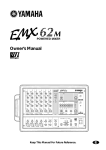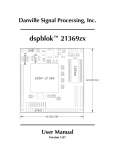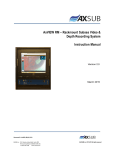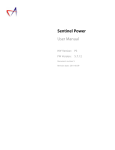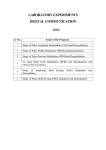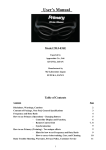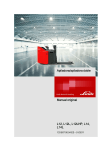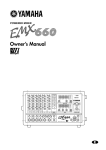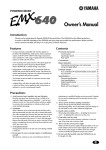Download Yamaha EMX620 Owner`s manual
Transcript
Owner’s Manual 1 2 HIGH 3 HIGH 4 HIGH 5 HIGH SEE REAR PANEL CAUTION 6 HIGH POWER HIGH VOCAL –15 +15 LOW –15 +15 LOW –15 +15 MONI –15 +15 MONI 0 EFFECT 0 LEVEL 10 10 –15 +15 LOW –15 +15 MONI 0 EFFECT 0 LEVEL 10 10 –15 +15 LOW –15 +15 MONI 0 EFFECT 10 0 LEVEL 10 –15 +15 LOW –15 +15 MONI 0 EFFECT 0 LEVEL 10 10 –15 +15 LOW PHANTOM L HALL –15 +15 ON OFF S HALL MONI 0 EFFECT 0 LEVEL 10 10 LIMITER 0 EFFECT 0 LEVEL 10 10 ON DIGITAL EFFECT –12 • 6 • 0 • 6 • +12 –12 • 6 • 0 • 6 • +12 125 0 10 PAD 0 10 PAD 0 10 PAD 0 10 0 10 0 3 4 Hi-Z Hi-Z Hi-Z Hi-Z 5 LINE 1 Lo-Z Lo-Z 10 EFFECT RTN 2 500 1k 2k 4k 8k 0 10 EFFECT RTN 10 PAD 1 Lo-Z 0 250 +6 +3 0 –5 –10 6 EFFECT INST EFFECT OUT 0 10 0 AUX IN 10 0 TAPE IN 10 0 MASTER 10 MASTER MAIN MONI MONITOR 1 TAPE IN REC OUT 1 1 2 2 Lo-Z LINE 2 INST FOOT SW MAIN PHONES AUX IN 2 INPUT TO MAIN Keep This Manual For Future Reference. OUTPUT E FCC INFORMATION (U.S.A.) 1. IMPORTANT NOTICE: DO NOT MODIFY THIS UNIT! This product, when installed as indicated in the instructions contained in this manual, meets FCC requirements. Modifications not expressly approved by Yamaha may void your authority, granted by the FCC, to use the product. 2. IMPORTANT: When connecting this product to accessories and/or another product use only high quality shielded cables. Cable/s supplied with this product MUST be used. Follow all installation instructions. Failure to follow instructions could void your FCC authorization to use this product in the USA. 3. NOTE: This product has been tested and found to comply with the requirements listed in FCC Regulations, Part 15 for Class “B” digital devices. Compliance with these requirements provides a reasonable level of assurance that your use of this product in a residential environment will not result in harmful interference with other electronic devices. This equipment generates/uses radio frequencies and, if not installed and used according to the instructions found in the users manual, may cause interference harmful to the operation of other electronic devices. Compliance with FCC regulations does not guarantee that interference will not occur in all installations. If this product is found to be the source of interference, which can be determined by turning the unit “OFF” and “ON”, please try to eliminate the problem by using one of the following measures: Relocate either this product or the device that is being affected by the interference. Utilize power outlets that are on different branch (circuit breaker or fuse) circuits or install AC line filter/s. In the case of radio or TV interference, relocate/reorient the antenna. If the antenna lead-in is 300 ohm ribbon lead, change the lead-in to coaxial type cable. If these corrective measures do not produce satisfactory results, please contact the local retailer authorized to distribute this type of product. If you can not locate the appropriate retailer, please contact Yamaha Corporation of America, Electronic Service Division, 6600 Orangethorpe Ave, Buena Park, CA 90620 The above statements apply ONLY to those products distributed by Yamaha Corporation of America or its subsidiaries. WARNING: THIS APPARATUS MUST BE EARTHED IMPORTANT THE WIRES IN THIS MAINS LEAD ARE COLOURED IN ACCORDANCE WITH THE FOLLOWING CODE: GREEN-AND-YELLOW : EARTH BLUE : NEUTRAL BROWN : LIVE As the colours of the wires in the mains lead of this apparatus may not correspond with the coloured markings identifying the terminals in your plug, proceed as follows: The wire which is coloured GREEN and YELLOW must be connected to the terminal in the plug which is marked by the letter E or by the safety earth symbol or coloured GREEN and YELLOW. The wire which is coloured BLUE must be connected to the terminal which is marked with the letter N or coloured BLACK. The wire which is coloured BROWN must be connected to the terminal which is marked with the letter L or coloured RED. * This applies only to products distributed by YAMAHA KEMBLE MUSIC (U.K.) LTD. Important 3 Important Read the following before operating the EMX620 Warnings • Do not allow water to enter this unit or allow the unit to become wet. Fire or electrical shock may result. • Connect this unit’s power cord only to an AC outlet of the type stated in this Owner’s Manual or as marked on the unit. Failure to do so is a fire and electrical shock hazard. • Do not scratch, bend, twist, pull, or heat the power cord. A damaged power cord is a fire and electrical shock hazard. • Do not place heavy objects, including this unit, on top of the power cord. A damaged power cord is a fire and electrical shock hazard. In particular, be careful not to place heavy objects on a power cord covered by a carpet. • If you notice any abnormality, such as smoke, odor, or noise, or if a foreign object or liquid gets inside the unit, turn it off immediately. Remove the power cord from the AC outlet. Consult your dealer for repair. Using the unit in this condition is a fire and electrical shock hazard. • Should this unit be dropped or the cabinet be damaged, turn the power switch off, remove the power plug from the AC outlet, and contact your dealer. If you continue using the unit without heeding this instruction, fire or electrical shock may result. • If the power cord is damaged (i.e., cut or a bare wire is exposed), ask your dealer for a replacement. Using the unit with a damaged power cord is a fire and electrical shock hazard. • Do not remove the unit’s cover. You could receive an electrical shock. If you think internal inspection, maintenance, or repair is necessary, contact your dealer. • Do not modify the unit. Doing so is a fire and electrical shock hazard. Cautions • Allow enough free space around the unit for normal ventilation. This should be: 30 cm at the sides, 30 cm behind, and 40 cm above. These distances should also be adopted when rack-mounting the unit. For normal ventilation during use, remove the rear of the rack or open a ventilation hole. If the airflow is not adequate, the unit will heat up inside and may cause a fire. • This unit has ventilation holes at the front, rear and sides to prevent the internal temperature rising too high. Do not block them. Blocked ventilation holes are a fire hazard. • Clean phone plugs before plugging them into the speaker jacks of this unit. Dirty contacts may generate heat. • Use only designated speaker cables to connect speakers to the amplifier outputs. Using other types of cable is a fire hazard. • Hold the power cord plug when disconnecting it from an AC outlet. Never pull the cord. A damaged power cord is a potential fire and electrical shock hazard. • Do not touch the power plug with wet hands. Doing so is a potential electrical shock hazard. EMX620—Owner’s Manual 4 Important Operating Notes • Using a mobile telephone near this unit may induce noise. If noise occurs, use the telephone away from the unit. • XLR-type connectors are wired as follows: pin 1: ground, pin 2: hot (+), and pin 3: cold (–). • Do not set all equalizer controls and faders to maximum. Doing so may cause oscillation depending on the condition of the connected unit and speakers, and may damage the speakers. • The performance of components with moving contacts, such switches, rotary controls, faders, and connectors, deteriorates over time. The rate of deterioration depends on the operating environment and is unavoidable. Consult your dealer about replacing defective components. EMX620—Owner’s Manual Introduction 5 Introduction Thank you for purchasing the Yamaha EMX620 Powered Mixer. In order to take full advantage of the EMX620 and enjoy long and trouble-free operation, read this owner’s manual carefully, and keep it in a safe place for future reference. Features • The EMX620’s six input channels support a wide range of audio sources, including microphones, instruments, and line-level devices. Input channels 1 through 4 feature lo- and hi-impedance balanced inputs, with +15 V phantom powering for use with condenser-type microphones on the lo inputs, input channel 5 features two line-level inputs, while input channel 6 features two hi-impedance inputs for connecting instruments such as electric-acoustic guitar and electric bass directly. • The built-in power amplifier offers a maximum output of 200 W with a 4Ω speaker system, 135 W with an 8Ω speaker system, and a limiter circuit prevents sounds distortion and speaker damage. • The 7-band graphic equalizer on the main output allows you to tailor the sound for each particular venue and reduce the risk of feedback by attenuating troublesome frequencies. Contents Front & Rear Panels.................................. 6 Control Panel ............................................ 6 Input/Output Panel ................................... 9 Rear Panel ................................................ 11 Hookup Example...................................... 12 Basic Operation....................................... 13 Connecting Sources ................................. 13 Monitoring............................................... 13 Using the Built-in Effects........................... 13 Troubleshooting...................................... 14 Specifications .......................................... 15 General Specifications .............................. 15 Input Specifications .................................. 16 Output Specifications ............................... 16 Dimensions .............................................. 16 Block & Level Diagrams............................ 17 • Also built-in is a digital effects processor, offering three different programs for adding reverberation or ambiance to vocal or instrument sounds, and remote on/off control using an optional footswitch. • External effects can be patched into the system via the EFFECT OUT and AUX IN jacks, with effects return level control. • Separate outputs are provided for connecting powered monitor speakers, headphones, or a stereo recorder (cassette, DAT, or MD). EMX620—Owner’s Manual 6 Front & Rear Panels Front & Rear Panels Control Panel ■ Channel Section The channel controls are used to set the EQ, MONI and EFFECT send levels, channel LEVEL, and PAD for each channel. 1 HIGH 1 –15 +15 LOW –15 +15 MONI 2 0 EFFECT 10 0 LEVEL 10 0 10 4 PAD 1 1 HIGH & LOW EQ controls The 2-band equalizer allows you to boost or cut the low or high frequency range for each channel. The frequency response is flat when the controls are in the center (▼) position. Rotating clockwise boosts frequencies, rotating counterclockwise cuts them. The center frequencies are as follows: HIGH: 10 kHz ±15 dB shelving type LOW: 100 Hz ±15 dB shelving type B MONI control The MONI control determines the level of the input signal that is fed to the MONI bus and subsequently the MONITOR OUTPUT jack. The MONI control is not affected by the channel’s LEVEL control, since the MONI signal is sourced before that control. EMX620—Owner’s Manual The EFFECT control determines the level of the input signal that is fed to the EFFECT bus and subsequently the onboard effects processor and EFFECT OUT jack. EFFECT bus signals are fed simultaneously to the onboard effects processor and the EFFECT OUT jack for use with external effects processors. The EFFECT control is affected by the channel’s LEVEL control, since the EFFECT signal is sourced after that control. To send a channel signal to the EFFECT bus, both the EFFECT and LEVEL controls must be turned up. D LEVEL control 3 5 C EFFECT control The LEVEL control determines the level of the input signal that is fed to the MAIN bus, MAIN output section, and internal power amplifier. E PAD switch (1–4 only) The PAD switch attenuates the input signal by 30 dB. When connecting a line-level source to inputs 1 through 4, or if a microphone signal is distorted, use the PAD switch to attenuate the input signal. 7 Control Panel ■ DIGITAL EFFECT Section ■ MAIN Section The DIGITAL EFFECT section is used to turn the built-in digital effects processor on and off and select effects programs. The MAIN section is used to set the MAIN MASTER level, 7-band graphic equalizer, AUX IN and TAPE IN levels, and MAIN EFFECT RTN level. It also contains the LIMITER indicator and main output level meter. VOCAL L HALL 8 6 LIMITER D S HALL ON 7 –12 • 6 • 0 • 6 • +12 DIGITAL EFFECT –12 • 6 • 0 • 6 • +12 125 0 250 10 EFFECT RTN 500 1k 0 2k 10 4k 8k 0 AUX IN +6 +3 0 –5 –10 10 0 C 10 TAPE IN MASTER A B MAIN EFFECT F VOCAL, L. HALL, S. HALL switches These switches are used to select the effects programs: VOCAL, L. HALL (large hall), S. HALL (small hall). G DIGITAL EFFECT ON switch & indicator The DIGITAL EFFECT ON switch is used to turn the built-in digital effects processor on and off. The indicator lights up when the processor is on. When the processor is on, its output is fed to the MAIN and MONI buses via the MAIN EFFECT RTN and MONI EFFECT RTN controls respectively. The effects processor can also be turned on and off remotely by connecting an optional footswitch to the FOOT SW jack. 9 0 H Graphic equalizer The 7-band graphic equalizer is used to boost or cut certain frequencies of the MAIN output signal by up to ±12 dB. It affects the MAIN OUTPUT signal, the speaker outputs, and the PHONES. I EFFECT RTN control The MAIN EFFECT RTN control determines the level of the signal from the built-in digital effects processor that is fed to the MAIN bus and subsequently the MAIN outputs. J AUX IN control The AUX IN control determines the level of the AUX IN signal that is fed to the MAIN bus and subsequently the MAIN outputs. K TAPE IN The TAPE IN control determines the level of the TAPE IN signal that is fed to the MAIN bus and subsequently the MAIN outputs. L MASTER control The MAIN MASTER control determines the output level of the MAIN OUT, speaker outputs, and PHONES. M Level meter The 5-LED meter displays the level of the MAIN output signal. EMX620—Owner’s Manual 8 Front & Rear Panels N LIMITER indicator The LIMITER indicator lights up when the limiter circuit, which is designed to protect the internal power amplifier against excessive input signals and load mismatches, activates. If the LIMITER indicator lights up, back off the MAIN MASTER level control, or the appropriate channel LEVEL control a little. If the indicator remains lit, make sure that the impedance of the connected speaker system is correct. The MONI section is used to set the MONI MASTER level and MONI EFFECT RTN level. E 10 EFFECT RTN F 0 10 MASTER MONI O EFFECT RTN The MONI EFFECT RTN control determines the level of the signal from the built-in digital effects processor that is fed to the MONI bus and subsequently the MONITOR OUTPUT. P MASTER control The MONI MASTER control determines the output level of the MONITOR OUTPUT. EMX620—Owner’s Manual POWER G PHANTOM ON OFF H Q POWER indicator ■ MONI Section 0 ■ POWER Indicator, PHANTOM Switch & Indicator The POWER indicator lights up when the EMX620 is powered up ready for use. R PHANTOM switch The PHANTOM switch is used to turn on and off the +15 V phantom power for the Lo-Z XLR-type inputs on input channels 1 through 4. Input/Output Panel 9 Input/Output Panel A 4 Hi-Z Hi-Z Hi-Z Hi-Z LINE 1 Lo-Z Lo-Z Lo-Z INST MONITOR EFFECT OUT 1 TAPE IN 1 1 2 2 Lo-Z LINE 2 INST FOOT SW MAIN PHONES AUX IN 2 INPUT TO MAIN 1 2 3 1 Hi-Z, Lo-Z (inputs 1–4) 5 6 OUTPUT 78 9 0 C INST 1 & 2 (input 6) These are the input connectors for input channels 1 through 4. Both the Hi-Z and Lo-Z input can be used with microphones and, by using the PAD switch, can also be used with line-level sources, such as synthesizers and drum machines. Switchable +15 V phantom power is available to the Lo-Z XLR-type input for use with condenser-type microphones. Both the Hi-Z and Lo-Z inputs are balanced. Pin connections are as follows. Lo-Z (XLR-type) REC OUT Hi-Z (TRS phone jack) Pin 1: ground Sleeve: ground Pin 2: hot (+) Ring: cold (–) Pin 3: cold (–) Tip: hot (+) S R T These two phone jacks are the input connectors for input channel 6. They are unbalanced, can be used simultaneously, and their high input impedance makes them ideal for use with instruments such as electric-acoustic guitar and electric bass. They can also be used with line-level sources, such as synthesizers and drum machines. D EFFECT OUT jack The EFFECT OUT phone jack outputs the signal from the EFFECT bus and can be connected to the input of an external effects processor. E FOOT SW jack The FOOT SW jack is used to connect an optional footswitch, such as the Yamaha FC5, which can be used to turn the built-in digital effects processor on and off. The DIGITAL EFFECT ON switch must be in the ON position in order to use the footswitch. F AUX IN—INPUT TO MAIN jack + - GND GND - + Note: The Lo-Z and Hi-Z input of each channel cannot be used simultaneously. Use the input appropriate for the source. Note: Since phantom power is turned on and off for inputs channels 1 through 4 simultaneously, input devices that do not require it should be connected to the Hi-Z input when phantom power is used. B LINE 1 & 2 (input 5) These two phone jacks are the input connectors for input channel 5. They are unbalanced, can be used simultaneously, and are appropriate for use with line-level sources, such as synthesizers and drum machines. The AUX IN—INPUT TO MAIN phone jack is used to feed signals from an external source to the MAIN bus and can be connected to the output of an external effects processor, for example. G TAPE IN—INPUT TO MAIN jacks The TAPE IN—INPUT TO MAIN phono jacks are used to feed signals from an external source to the MAIN bus and can be connected to the stereo outputs of a cassette, DAT, or MD deck. H REC OUT—OUTPUT jacks The REC OUT—OUTPUT phono jacks output the MAIN bus signal prior to the 7-band graphic equalizer and MASTER level control, and can be connected to the stereo inputs of a cassette, DAT, or MD deck for recording. EMX620—Owner’s Manual 10 Front & Rear Panels I MAIN—OUTPUT jack The MAIN—OUTPUT jack outputs the MAIN bus signal after the 7-band graphic equalizer and MASTER level control, and can be connected to the input of a larger mixer, or a more powerful amplifier, for example. J PHONES—OUTPUT jack The PHONES—OUTPUT jack outputs the MAIN bus signal after the 7-band graphic equalizer and MASTER level control, and can be connected to a pair of stereo headphones for personal monitoring. K MONITOR—OUTPUT The MONITOR—OUTPUT phone jack outputs the MONI bus signal after the MONI MASTER control, and can be connected to the input of a powered monitor speaker. EMX620—Owner’s Manual Rear Panel 11 Rear Panel POWERED MIXER MODEL EMX620 POWER ON OFF B—SPEAKERS—A 1 2 1 POWER switch B SPEAKERS A & B jacks The POWER switch is used to turn on and off the power to the EMX620. Note: Before turning on or off the EMX620, it’s a good idea to turn down the MAIN MASTER and MONI MASTER controls. The SPEAKER A & B phone jacks output the main signal from the internal power amplifier and are used to connect speakers. They are internally connected in parallel and output the same signal. The total impedance of the connected speaker system must be between 4 and 8 ohms. This means that you can connect one speaker system with an impedance of between 4 and 8 ohms to one SPEAKER jack, or two speaker systems each with an impedance of between 8 and 16 ohms to each SPEAKER jack, as shown below. Connecting one speaker B—SPEAKERS—A 4Ω–8Ω Connecting two speakers B—SPEAKERS—A 8Ω–16Ω 8Ω–16Ω Note: Do not connect anything other than speakers to these jacks. EMX620—Owner’s Manual 12 Front & Rear Panels Hookup Example Recorder (Cassette, DAT, MD) CD player Effects processor 88 Synthesizer, Drum machine, Guitar processor Hi-Z Hi-Z Hi-Z Powered monitor Hi-Z LINE 1 Lo-Z Lo-Z Lo-Z INST MONITOR EFFECT OUT 1 TAPE IN REC OUT 1 1 2 2 Lo-Z LINE 2 INST FOOT SW MAIN PHONES AUX IN 2 INPUT TO MAIN *1 Footswitch (YAMAHA FC5) OUTPUT *2 Headphones Larger mixer or Amplifier Microphone B—SPEAKERS—A Electric-acoustic guitar Electric bass * The Lo-Z and Hi-Z input of each channel cannot be used simultaneously. *1. Although this example shows an external effects processor and footswitch, which is used to turn on and off the built-in digital effects processor, connected to the EMX620, in practice, only one effects processor, internal or external, will be used at a time, so the footswitch is not required when using external effects. *2. This example shows both headphones and a powered monitor being used for monitoring. In practice, however only one method is required. EMX620—Owner’s Manual Basic Operation 13 Basic Operation Connecting Sources Before connecting any microphones or instruments, make sure that the EMX620 and any other applicable equipment is turned off. Also make sure that the LEVEL control on each EMX620 input channel, and the MAIN MASTER and MONI MASTER controls are turned down. 1 Connect cables to your mics and instruments, and insert the other end of the cables firmly into the appropriate Lo-Z or Hi-Z jack (channels 1–4), LINE jack (channel 5), or INST jack (channel 6). Note: When connecting line-level sources to input channels 1 through 4, turn on the corresponding PAD switch. Note: The Lo-Z and Hi-Z jacks on input channels 1 through 4 cannot be used simultaneously. B Turn on the power, starting with the sound sources and finishing with the EMX620. Reverse this order when turning off the power. C Set the MAIN MASTER control to the √ position. D While speaking into a connected mic, or playing a connected instrument, adjust the input channel LEVEL control so that the 0 LED of the MAIN section level meter lights occasionally. Repeat this procedure for each channel. E Use the EQ controls on each input channel to adjust the tonal characteristics of each source. F Use the 7-band graphic equalizer to adjust the tonal characteristics of the main output. G Use the MAIN MASTER control to set the overall volume level of the main mix. Monitoring By connecting a powered monitor speaker to the MONITOR OUTPUT, you can create a monitor mix independent of the MAIN mix, since the input channel MONI controls are not affected by the LEVEL controls. 1 Set the MONI MASTER control to the √ position. B While speaking into a connected mic, or playing a connected instrument, adjust the MONI control of the input channel that you want to monitor. Repeat this procedure for each channel. C Use the MONI MASTER control to set the overall level of the monitor mix. Using the Built-in Effects The EMX620 features a built-in digital effects processor, allowing reverberation or ambiance to be added to vocals or instrument sounds. 1 Turn on the digital effects processor by pressing the DIGITAL EFFECT ON switch. The DIGITAL EFFECT indicator lights up. B Use the DIGITAL EFFECT switches to select an effects program. VOCAL ...... Reverb suitable for vocals. L. HALL...... Reverb typical of a large hall. S. HALL...... Reverb typical of a small hall. C Set the MAIN EFFECT RTN control to the √ position. D While speaking into a connected mic, or playing a connected instrument, adjust the EFFECT control of the input channel that you want to process. E Use the MAIN EFFECT RTN control to adjust the overall level of the processed sound. F Use the MONI EFFECT RTN control to feed the processed signal to the MONI bus and subsequently MONITOR OUTPUT. Note: If the processed sound is distorted even with an EFFECT RTN control turned down, turn down the EFFECT control on each channel. EMX620—Owner’s Manual 14 Troubleshooting Troubleshooting The following table describes the possible malfunctions of this demvice, and the appropriate actions to be taken in each case. Problem The POWER indicator is lit. Cause Action The load on the amplifier of this device was too great, and the protection circuit for the amplifier has operated. Possible reasons for the excessive load are an excessive level setting in the channel control section or main section, insufficient ventilation, or insufficient load impedance of the connected speakers. Please wait. When the device cools off, normal operation will resume automatically. However, please check the following three points to prevent the problem from recurring. If the level setting is excessive, lower it to the nominal level. You can refer to the peak level indicators of the main section when doing so. If the device is not ventilated sufficiently, refer to the cautions given at the beginning of this manual and take appropriate measures to insure adequate ventilation. If the load impedance (including a short) is too low, refer to the chapter on rear panel (page 11) and change the connections so that the impedance is correct. Sound is no longer output from the speakers. Connections between devices have come Inspect the connections, and correct any faulty loose. connections. Other Other EMX620—Owner’s Manual The device may have malfunctioned. Please contact your dealer. Specifications 15 Specifications ■ General Specifications Maximum output power 135 W/8Ω @0.5% THD at 1 kHz (SPEAKERS OUT) 200 W/4Ω @0.5% THD at 1 kHz (SPEAKERS OUT) 175 mW/40Ω @0.5% THD at 1 kHz (PHONES OUT) Frequency response 20 Hz–20 kHz +1 dB, –3 dB @1 W output into 8Ω (SPEAKERS OUT) 20 Hz–20 kHz +1 dB, –3 dB @+4 dB output into 10 kΩ (MAIN OUT, MONITOR OUT, EFFECT OUT) Total harmonic distortion Less than 0.5% @20 Hz–20 kHz, 100 W output into 4Ω (SPEAKERS OUT) Less than 0.3% @20 Hz–20 kHz, +14 dB output into 10 kΩ (MAIN OUT, MONITOR OUT, EFFECT OUT) –124 dB equivalent input noise, –68 dB residual output noise (SPEAKERS OUT) –88 dB residual output noise (MAIN OUT, MONITOR OUT) Hum & noise (Average, Rs=150Ω) (with 20 Hz–20 kHz BPF) –79dB (83 dB S/N) (MAIN OUT, MONITOR OUT) Master level control: nominal level Channel level controls: minimum –69 dB (73 dB S/N) (MAIN OUT, MONITOR OUT) Master level control: nominal level 1 channel level control: nominal level –75 dB (79 dB S/N) (EFFECT OUT) All channel level controls: minimum –69 dB (73 dB S/N) (EFFECT OUT) 1 channel level control: nominal level Maximum voltage gain (PAD: OFF) 86 dB CH IN (Lo-Z) to SPEAKERS OUT (CH1–4) 66 dB CH IN (Lo-Z) to MAIN OUT, MONITOR OUT (CH1–4) 66 dB CH IN (Lo-Z) to EFFECT OUT (CH1–4) 48 dB CH IN (Lo-Z) to REC OUT (CH1–4) 56 dB CH IN (Hi-Z) to MAIN OUT, MONITOR OUT (CH1–4) 26 dB LINE IN to MAIN OUT 26 dB AUX IN to MAIN OUT 22 dB TAPE IN to MAIN OUT 46 dB INST IN to MAIN OUT Crosstalk at 1 kHz –65 dB adjacent input, –65 dB input to output Input channel equalization ±15 dB Maximum HIGH 10 kHz shelving * LOW 100 Hz shelving * * Turn over/roll-off frequency of shelving: 3 dB below maximum variable level. Meters 5 points LED Meter (–10, –5, 0, +3, +6 dB) MAIN OUT Graphic equalizer 7 bands (125, 250, 500, 1k, 2k, 4k, 8k Hz) MAIN OUT ±12 dB Maximum Internal digital effect 3 types (Vocal, L Hall, S Hall) Phantom power +15 V is supplied to electrically balanced inputs for powering condenser microphones via 2.4 kΩ current limiting/isolation resisters. Limiter Comp. : THD≥0.5% (SPEAKERS) LIMIT indicator Turn on. : THD≥0.5% (SPEAKERS) Protection circuit (Power amp) POWER switch on/off mute DC detection Temp (Heatsink Temp≥90°C) Foot switch DIGITAL EFFECT MUTE : on/off Power requirement USA and Canada: 120 V AC 60 Hz Europe: 230 V AC 50 Hz Other: 240 V AC 50 Hz Power consumption 110 W Dimensions (WxHxD) 497×275×275 mm Weight 13 kg For European Model Purchaser/User Information specified in EN55103-1 and EN55103-2. Inrush Current: 23A Conformed Environment: E1, E2, E3 and E4 EMX620—Owner’s Manual 16 Specifications ■ Input Specifications Input connectors PAD CH INPUT (Lo-Z) (CH1–4) OFF CH INPUT (Hi-Z) (CH1–4) OFF ON ON Actual load impedance 3 kΩ 10 kΩ Input level Nominal impedance Sensitivity*1 Nominal level Max. before cliping Connector type 50–600Ω Mics –62 dB (0.616 mV) –50 dB (2.45 mV) –20 dB (77.5 mV) 600Ω Lines –32 dB (19.5 mV) –20 dB (77.5 mV) +10 dB (2.45 V) 50–600Ω Mics –52 dB (1.95 mV) –40 dB (7.75 mV) –10 dB (245 mV) 600Ω Lines –22 dB (61.6 mV) –10 dB (245 mV) +20 dB (7.75 V) Phone jack (TRS)*2 XLR-3-31 type*2 LINE IN (CH5) (1–2) 10 kΩ 600Ω Line –22 dB (61.6 mV) –10 dB (245 mV) +20 dB (7.75 V) Phone jack *3 INST IN (CH6) (1–2) 470 kΩ 1kΩ –42 dB (6.16 mV) –30 dB (24.5 mV) 0 dB (0.775 V) Phone jack *3 AUX IN 10 kΩ 600Ω Line –22 dB (61.6 mV) –10 dB (245 mV) +20 dB (7.75 V) Phone jack *3 TAPE IN (1–2) 10 kΩ 600Ω Line –22 dBV (79.4 mV) –10 dBV (316 mV) +17.8 dBV (7.76 V) Phono jack *1. Sensitivity is the lowest level that can produce an output of +4 dB (1.23 V) or the nominal output level when the unit is set at maximum gain. (All level controls are at maximum position.) *2. Balanced. (T= HOT, R= COLD, S= GND) *3. Unbalanced. • 0 dB= 0.775 Vrms, 0 dBV= 1 Vrms. ■ Output Specifications Output level Actual source impedance Nominal impedance Nominal Max. before cliping 0.1Ω 4/8Ω Speaker 37.7 W/4Ω 200 W/4Ω Phone jack MAIN OUT 600Ω 10 kΩ Lines +4 dB (1.23 V) +20 dB (7.75 V) Phone jack MONITOR OUT 600Ω 10 kΩ Lines +4 dB (1.23 V) +20 dB (7.75 V) Phone jack EFFECT OUT 600Ω 10 kΩ Lines +4 dB (1.23 V) +20 dB (7.75 V) Phone jack PHONES OUT 35Ω 40 Ω Phones 33 mW 175 mW Phone jack REC OUT (1, 2) 600Ω 10 kΩ Lines –10 dBV (316 mV) +10 dBV (3.16 V) Phono jack Output connectors SPEAKERS OUT (A, B) Connector type • PHONE JACKS are unbalanced. • 0 dB= 0.775 Vrms, 0 dBV= 1 Vrms. ■ Dimensions 168 (45.5) H:275 259 (45.5) W:497 45.5 380 45.5 487 16 57.5 150 (67.5) D:275 Unit: mm Specifications are subject to change without prior notice. EMX620—Owner’s Manual CH6 IN CH5 IN CH IN 1-4 –50dB –40dB –30dB –20dB –10dB 0dB +10dB +20dB +30dB INST [–30dB] LINE [–10dB] 2 1 2 1 Hi-Z [–40/–10] Lo-Z [–50/–20] Lo-Z, MIC [–50dB] INST IN [–30dB] Hi-Z [–40dB] Lo-Z [–20dB] Hi-Z [–10dB] HA HA FOOT SW (MITE) TAPE IN [–10dBV] [–7.8dB] [–10dB] ON OFF [–10dB] 2 1 [–10dB] BA BA 2-Stage EQ 2-Stage EQ 2-Stage EQ AUX IN [–10dB] TAPE IN [–10dBV] Clip Level [+20dB] S HALL L HALL VOCAL AUX IN [–10dB] PAD [–10dB] LINE IN [–10dB] [–10dB] PAD HA Lo Lo Lo +15V Hi Hi Hi DIGITAL EFFECT ON [0dB] ON ON ON [–16dB] TAPE IN [–16dB] AUX IN LEVEL [–10dB] LEVEL [–10dB] LEVEL [–10dB] MAIN [0dB] [–16dB] ON EFFECT MONI SUM SUM SUM MAIN,MONI [–16dB] EFFECT [–22dB] TAPE,AUX [–6dB] EFFECT RTN [–6dB] EFFECT RTN SUM MONI [–22dB] EFFECT [–16dB] [–16dB] MONI [–22dB] EFFECT [–16dB] [–16dB] [–22dB] MONI EFFECT [–16dB] [0dB] [0dB] [0dB] REC OUT [–10dBV] [–7.8dB] 7-Stage GEQ 2 1 [–6dB] BA BA [–6dB] MASTER MASTER REC OUT [–10dBV] 125Hz 250Hz 500Hz 1kHz 2kHz 4kHz 8kHz PHANTOM OFF EFFECT OUT [+4dB] MONITOR OUT [+4dB] MAIN OUT [+4dB] MAIN OUT, MONITOR OUT, EFFECT OUT [+4dB] BA LED METER 1 2 JK2 JK1 PHONE B A PHONE (33mW 40Ω) PHONE max (175mW 40Ω) 37.7W/4Ω –50dB –40dB –30dB –20dB –10dB 0dB +10dB +20dB +30dB SPEAKERS [200W/4Ω] SPEAKERS MAXIMUM OUTPUT POWER [200W/4Ω] LIMIT PA 1 2 Block & Level Diagrams 17 ■ Block & Level Diagrams EMX620—Owner’s Manual YAMAHA CORPORATION V474530 R1 1 IP 20 Printed in Taiwan Pro Audio Division, #18/3 P.O. Box 3, Hamamatsu, 430-8651, Japan
This document in other languages
- română: Yamaha EMX620
- français: Yamaha EMX620
- español: Yamaha EMX620
- Deutsch: Yamaha EMX620
- русский: Yamaha EMX620
- Nederlands: Yamaha EMX620
- dansk: Yamaha EMX620
- polski: Yamaha EMX620
- čeština: Yamaha EMX620
- svenska: Yamaha EMX620
- italiano: Yamaha EMX620
- português: Yamaha EMX620
- Türkçe: Yamaha EMX620


















